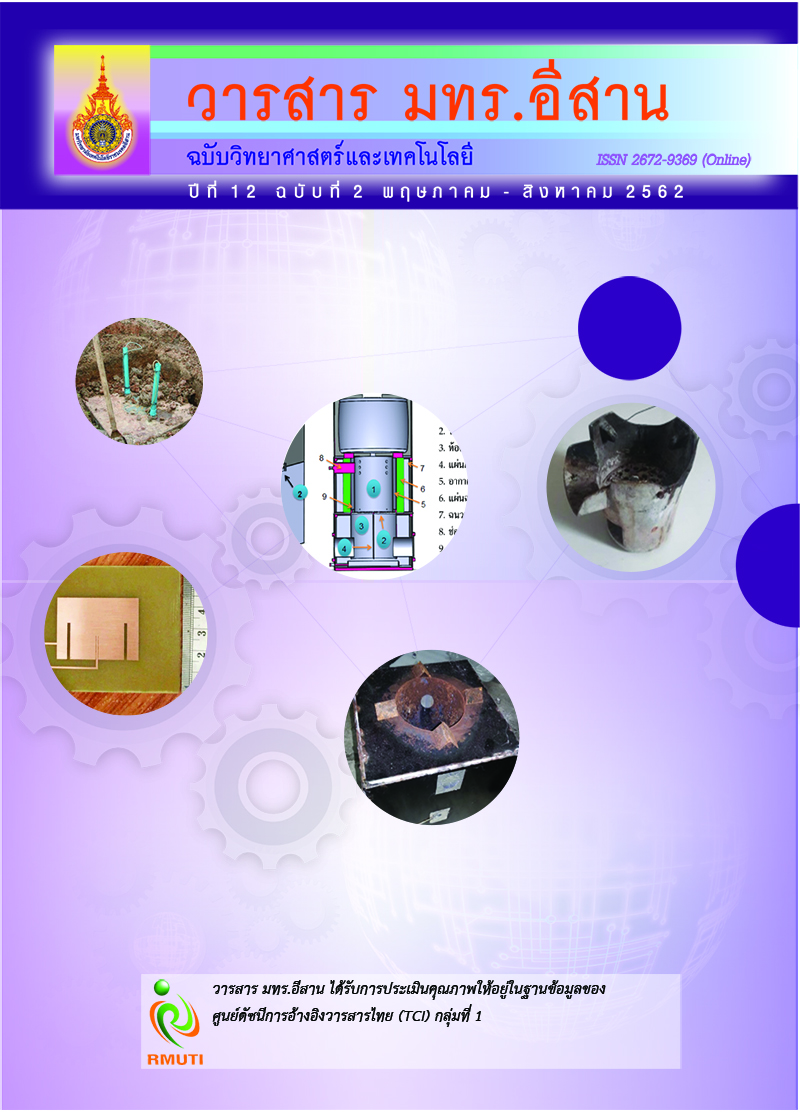Occurrence of Total Heterotrophic Bacteria Isolated from Litopenaeus vannamei Sold in Chon Buri Province, Thailand
Main Article Content
Abstract
A study regarding quantity and distribution of total heterotrophic bacteria isolated from 40 samples of Litopenaeus vannamei purchased in Chon Buri Province, Thailand was conducted. Results showed that total heterotrophic bacteria ranged from 3.13 x 104 to 1.50 x 107 CFU/g. The most predominant heterotrophic bacteria in this study were Flavobacterium spp. followed by the less extent numbers of Aeromonas spp., Bacillus spp., Vibrio spp., Staphylococcus spp., Pseudomonas spp., Corynebacterium spp., Moraxella spp., Enterobacter spp., Proteus spp., Serratia spp., Acinetobacter spp., Alcaligenes spp., Pasteurella spp., Citrobacter spp., Escherichia spp., Klebsiella spp., Yersinia spp. and Shigella dysenteriae, respectively. Based on a microbiological standard of total heterotrophic bacteria, most of the tested shrimp samples in this study did not meet the microbiological quality of USA, Australia, New Zealand and Japan.
Article Details
References
[2] Sudthonghong, C. (2018). White Feces Syndrome in Litopenaeus vannamei. Coastal Aquaculture Research and Development Regional Center 2 (Samutsakhon). Access (20 April 2017). Available (https://www4.fisheries.go.th/local/file_document/20170421131716_file.pdf)
[3] Utarapichat, B. (2009). Food Microbiology. Songkhla: Thaksin University Book Center. (in Thai)
[4] Wittman, R. J. and Flick, G. J. (1995). Microbial Contamination of Shellfish: Prevalence, Risk to Human Health, and Control Strategies. Annual Review of Public Health. Vol. 16, pp. 123-140. DOI: 10.1146/annurev.pu.16.050195.001011
[5] FDA. Maturin, L. J. and Peeler, J. T. (1998). Chapter 3: Aerobic Plate Count, Bacteriological Analytical Manual [BAM]. Access (3 August 2011). Available (https://www.scribd.com/doc/61 521962/Bacteriological-Analytical-Manual-BAM-BAM-Aerobic-Plate-Count)
[6] Holt, J. G. and Bergey, D. H. (1994). Bergey’s Manual of Determinative Bacteriology. Baltimore: Williams and Wilkins
[7] Hatha, A. A. M., Maqbool, T. K., and Kumar, S. S. (2003). Microbial Quality of Shrimp Products of Export Trade Produced from Aquacultured Shrimp. International Journal of Food
Microbiology. Vol. 82, pp. 213-221
[8] Dalsgaard, I. (2001). Selection of Media for Antimicrobial Susceptibility Testing of Fish Pathogenic Bacteria. Aquaculture. Vol. 196, No. 3-4, pp. 267-275
[9] Maclean, L. L., Vinogradov, E., Crump, E. M., Perry, M. B., and Kay, W. W. (2001). The Structure of the Lipopolysaccharide O-antigen Produced by Flavobacterium psychrophilum (259-93). European Journal of Biochemistry. Vol. 268, Issue 9, pp. 2710-2716. DOI: 10.1046/j.1432-1327.2001.02163.x
[10] Baron, E. J., Peterson, L. R., and Finegold, S. M. (1994). Bailey & Scott’s Diagnostic Microbiology. St. Louis: Mosby-Year Book
[11] Suwanphinid, N. (2004). Bacteria Associated with the Disease. Department of Biology, Faculty of Science, Srinakharinwirot University. Bangkok: Nobel Print. (in Thai)
[12] Food and Drug Administration. (2000). Kinetics of Microbial Inactivation for Alternative Food Processing Technologies. Access (22 April 2006). Available (http://www.cfsan.fda.gov/
~comm/ift-over.html)
[13] Nimrat, S., Sakanuchaichan, K., Chuersuwan, N. and Vuthiphandchai, V. (2005). Prevalence of Vibrio spp. in Aquatic Organisms Collected from Natural Environments and Aquaculture Systems. Burapha Science Journal. Vol. 10, No. 1-2, pp. 83-91
[14] Suwanphinid, N. and Suwanphinid, P. (2001). General Microbiology. (3rd ed.). Bangkok: Chulalongkorn University Printing House.
[15] Koneman, W. E., Allen, S. D., Janda, W. M., Schreckenberger, P. C., and Winn, W. C. (1997). Color Atlas and Textbook of Diagnostic Microbiology. Philadelphia: Lippincott
[16] Suphawed, S. and Wonchid, M. (1993). Basic Bacteria. Bangkok: Siriyod Printing.
[17] Kalamaki, M., Price, R. J., and Fung, D. Y. C. (1997). Rapid Methods for Identifying Seafood Microbial Pathogens and Toxins. Journal of Rapid Methods and Automation in Microbiology. Vol. 5, Issue 2. pp. 87-137. DOI: 10.1111/j.1745-4581.1997.tb00155.x
[18] Gautier, A. L., Dubois, D., Escande, F. O., Avril, J. L., Cuot, P. T., and Gaillot, O. (2005). Rapid and Accurate Identification of Human Isolate of Pasteurella and Related Species by
Sequencing the sodA Gene. Journal of Clinical Microbiology. Vol. 43, No. 5, pp. 2307-2314. DOI: 10.1128/JCM.43.5.2307-2314.2005
[19] Faruque, S. M., Khan, R., Kamruzzaman, M., Yamasaki, S., Ahmad, Q. S., Azim, T., Nair, G. B., Takeda, Y., and Sack, D. A. (2002). Isolation of Shigella dysenteriae Type 1 and S. flexneri Strains from Surface Waters in Bangladesh: Comparative Molecular Analysis of Environmental Shigella Isolates versus Clinical Strains. Applied and Environmental Microbiology. Vol. 68, No. 8, pp. 3908-3913. DOI: 10.1128/aem.68.8.3908-3913.2002
[20] Huss. H. H., Reilly, A., and Embarek, P. K. B. (2000). Prevention and Control of Hazards in Seafood. Food Control. Vol. 11, No. 2, pp. 149-156
[21] Lakshmanan, R., Shakila, R. J., and Jeyasekaran, G. (2002). Survival of Amine-Forming Bacteria During the Ice Storage of Fish and Shrimp. Food Microbiology. Vol. 19, Issue 6,
pp. 617-625. DOI: 10.1006/fmic.2002.0481
[22] Middlebrooks, B. L., Toom, P. M., Douglas, W. L., Harrison, R. E., and McDowell, S. (1998). Effects of Storage Time and Temperature on the Microflora and Amine-Development in Spanish Mackerel (Scomberomorus maculatus). Journal of Food Science. Vol. 53, Issue 4, pp. 1024-1029. DOI: 10.1111/j.1365-2621.1988.tb13522.x
[23] Fish Inspection and Quality Control Division Department of Fisheries. (2009). Microbiological Standards of the Product. Access (8 August 2018). Available (https://www.fisheries.go.th/quality/Std%20micro.php)
[24] ICMSF. (1986). Microorganisms in Foods 2 - Sampling for Microbiological Analysis: Principles and Specific Applications. Toronto, Ontario, Canada, University of Toronto Press (second edition). Access (29 March 2006). Available (http://seafood.ucdavis.edu/haccp/compendium/chapt09.htm)


